
| T H E N I H C A T A L Y S T | J U L Y – A U G U S T 2000 |
|
|
|
CON MUCHO GUSTO:HISPANIC SCIENTISTS AT NIH SHOWCASE THEIR RESEARCH |
by Cynthia Delgado |
In what its wearied but exhilarated organizers hope will be a continuing event at NIH, the first Hispanic Scientists Day (June 5) captured the diversity of research pursuits among NIH scientists who grew up in countries or homes where Spanish was the first or second language.
A brief nine months after the creation of an NIH Hispanic Scientists Directory, the research of 30 self-identified Hispanic scientists and their multinational colleagues from 15 different institutes across campus joined in a poster display following a keynote lecture by Juan Rivera, senior investigator and head of the Signal Transduction Group (see The NIH Catalyst, January–February 2000), NIAMS. Rivera’s NIH career started when he was a first-year college student and included working as a lab tech here while he was getting advanced degrees in immunology. His talk on Fc receptor signaling was further elaborated in one of the posters of the day, presented by Jesus Buonomo, a postbac student in his lab (see below).
Following is a small sample of the research presented that day.
 |
|
Alonzo
Garcia
|
Alonzo
García, postdoc, Laboratory of Viral Diseases, NIAID
Identification
and characterization of bacterial-type DNA Holliday junction resolvase in poxviruses
In 1964, Holliday proposed a model of homologous DNA recombination to explain the sequence of molecular events that occur between two chromosomes involved in genetic exchange. A structural intermediate of the model, and a catalytic "hot spot," was dubbed a Holliday junction (HJ). Since that time, the key molecular components of homologous recombination have been dissected in Escherichia coli. The dimeric endonuclease RuvC is one such component that resolves the HJ into duplex products by symmetrically nicking two of the four DNA strands. García and his colleagues at NIAID and the NLM’s National Center for Biotechnology Information are the first to identify a bacteria-like HJ resolvase in viruses that infect eukaryotic cells. He notes that "until now it had only been found in bacteriophages, bacteria, and yeast." His team is now exploring what role the enzyme plays in virus infection.
The team reported that with the aid of "protein alignment and threading programs, [they] identified critical structuralelements of RuvC . . . in uncharacterized open reading frames from all poxviruses and an iridovirus." The group noted that the gene product of the Vaccinia virus gene A22R had sequence nd structural similarities to the RuvC bacterial resolvase.
Further, they found that the recombinant protein rA22 specifically bound to and cleaved a synthetic HJ, yielding duplex molecules. This catalytic activity was not present against single- or double-stranded DNA, Y-junctions, or duplex-branched molecules. Although mutations in conserved amino acids in rA22 required for endonuclease activity abrogated catalytic activity, specific binding to the HJ was not inhibited. They postulated that the HJ resolvase plays a role during Vaccinia virus infection through its effects on viral DNA processing and resolution of recombinant DNA intermediates. This theory was supported by the absence of resolution when they co-transfected a mutated A22R and a cruciform-structure–containing plasmid (which has a "Holliday-like" junction) in cells infected with wild-type virus.
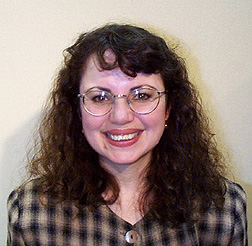 |
|
Carmen
M. Collazo-Custodio
|
Carmen
M. Collazo-Custodio, postdoc, Laboratory of Parasitic Diseases, NIAID:
The
IFN-g–inducible GTPase (IGTP) is required for
in vivo control of Toxoplasma gondii infection in both hematopoietic
and nonhematopoietic host cells
Toxoplasma gondii is an intracellular protozoan parasite and the etiologic agent responsible for toxoplasmosis. The early acute phase of infection is characterized by rapid replication in a variety of nucleated host cells. A potent cell-mediated immune response by the host is thought to result in a shift to the chronic phase in which slow-growing forms called bradyzoites are contained within tissue cysts. These cysts convey protective immunity but can also be the source of reactivated infection. Although the precise mechanisms are not fully understood, numerous studies have shown the importance of interferon-g (IFN-g) in both acute and chronic phases of T. gondii infection.
Collazo-Custodio and her NIAID colleagues, in collaboration with Gregory Taylor, a former NCI postdoc now at Duke University Medical Center in Durham, N.C., studied mice that lacked the IFN-g–inducible GTPase (IGTP) to determine the nature of its role in the intracellular control of T. gondii. They found that IGTP-deficient mice exhibited a complete loss of host resistance to infection, as well as the inability to clear the parasites from host tissues. These animals did, however, retain normal IL-12, IFN-g, and nitric oxide levels associated with essential mechanisms of the immune response
Reciprocal bone marrow chimeras between knockout and wild-type mice revealed the tissue compartments in which IGTP functions in host resistance. In the control group, wild-type mice reconstituted with wild-type bone marrow were resistant to T. gondii infection and displayed long-term survival. But wild-type mice reconstituted with knockout bone marrow and knockout mice reconstituted with either wild-type or knockout bone marrow exhibited similar profiles when infected, dying within 9 to 11 days of exposure. These observations, the team reported, indicate that "IGTP is required for control of T. gondii infection by both hematopoietic and nonhematopoietic cells and . . . is likely to be involved in the common intracellular pathway used by these two lineages to limit tachyzoite growth."
The group has now shifted its focus to the chronic phase of infection and to localization studies of IGTP in normal vs. infected cells.
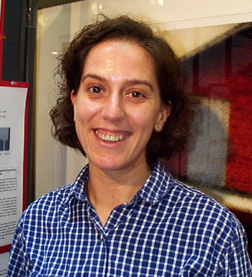 |
|
Maria
Ruiz-Hidalgo
|
Maria
Ruiz-Hidalgo, Fogarty fellow, Laboratory of Immunobiology, CBER, FDA:
Notch-1
is required for adipogenesis of 3T3-L1 cells and affects the way these cells
interpret the Ras signal
The Notch family of genes encodes transmembrane receptors, which are responsible for intracellular signals that affect cell fate during differentiation. Numerous reports have demonstrated that in some systems Notch expression is a characteristic of the undifferentiated state of many cell types during development. Ruiz-Hidalgo and her colleagues have found the contrary in their system.
Examining adipogenesis of 3T3-L1 cells, a well-characterized system of differentiation, the team showed that Notch-1 acted as an accessory to differentiate the cells. When Notch-1 signaling was blocked by ligand interference or transfection with constructs encompassing Notch-1 cDNA in antisense orientation, the cells remained in an undifferentiated state despite hormone induction. To explain this phenomenon, the team explored downstream events in the differentiation pathway, specifically, the expression of transcription factors of the helix-loop-helix family, such as PPARd and PPARg. They found that when Notch-1 expression was decreased, so was the expression of these transcription factors. "PPARg is especially important," says Ruiz-Hidalgo, "and PPARg expression is decreased when Notch-1 is not in the cells."
Their recent investigations suggest that the levels of expression of Notch-1 are important for the interpretation of extracellular signals. In opposition to previous reports indicating that constitutively active Ras induces adipogenesis of 3T3-L1 in the absence of inductors, they observed that activated Ras expression induced transformation and no differentiation in control 3T3-L1 cells and in cells with low Notch-1 expression. Interestingly, properties associated with oncogenic transformation were inversely proportional to the level of Notch-1 expression in these cells. This effect appeared to be mediated, at least in part, through a different pattern of activation of MAP kinase.
"With much more work," Ruiz-Hidalgo says, light could possibly be shed on new strategies to block malignant transformation or control the differentiation of cells grown for transplantation and cell therapy.
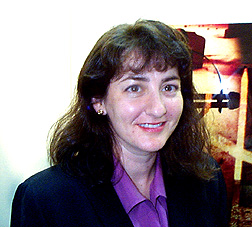 |
|
Carolina
Nadel
|
Carolina
Nadel, postdoc, NCBI, NLM:
Genes
and disease—a web site of short descriptions of inherited disorders
Nadel is a member of the team that provides ongoing update of the NCBI "Genes and Disease" web site, a collection of short reports on human genetic diseases. Although the site was established to disseminate information to the general public, it’s useful for physicians as well, she says. Each disease page includes a clinical synopsis, followed by the condition’s genetic underpinnings and, when applicable, information about the involved protein(s). The last paragraph, Nadel says, "usually looks to the future" and may describe mouse models, diagnostic factors, and treatment options.
Among the links that connect users to pertinent databases are OMIM, a comprehensive gene mapping site; LocusLink, for gene and loci information; and Entrez, a nucleotide and protein sequence databank integration site. The group plans to connect the site to the completed map of the human genome in the coming months. A link to the literature database PubMed, is "set up so that the key papers, usually two to three," will be listed, Nadel says. The relevant publications in the last six months are also presented upon a click on "recent literature." At the bottom of the page are "more links to support groups and information for patients and families."
The site now includes between 60 and 70 diseases organized by categories (for example, "cancer," "metabolism," "immune system"). The team is in the midst of reorganizing the information, however, to emphasize the disease itself rather than the molecular nature of its etiology.
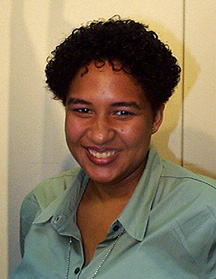 |
|
Yesenia
Rivera
|
Yesenia
Rivera, pre-IRTA cancer research trainee, Tumor
Cell Biology Section, Medicine Branch, NCI:
Geldanamycin,
an Hsp90 antagonist, blocks both NFkB and AKT-dependent
survial pathways in tumor cells
Rivera cites the wording in her group’s abstract to explain the rationale of their research: "Several anticancer drugs, including Adriamycin, have been shown to induce survival pathways in cancer cells, thus counteracting their own cytotoxicity. The transcription factor NFkB and kinase AKT mediate two of the survival pathways." She and her teammates are examining ways to block these pathways.
The group’s latest data demonstrate that geldanamycin (GA) can augment the cytotoxic effects of Adriamycin. GA is an antagonist to the chaperone protein Hsp90, which imbues stability and function to kinases involved in both pathways. GA exerts its effects by removing apoptotic blocks induced by Adriamycin along both pathways. For example, GA inhibited Adriamycin-induced NFkB activation, possibly by destabilizing IKK kinases (IKKa and IKKb), thereby blocking NFkB accumulation in the nucleus and promoting induction of apoptosis. Similarly, they found that GA destabilizes AKT, thus preventing the phosphorylation of an apoptotic transcription factor, FKHL1, resulting in its nuclear accumulation and the triggering of apoptosis.
The combination of Adriamycin and GA scored higher than either alone in assays for toxicity and apoptotic activity. A Phase I clinical trial of a GA derivative in the treatment of solid tumors is underway, and a Phase II trial of a combination GA-Adriamycin arm is being considered.
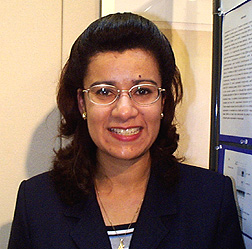 |
|
Nancy
Vazquez-Maldonado
|
Nancy
Vázquez-Maldonado, postdoc, Division of Therapeutic Proteins, CBER,
FDA:
IL-4 suppresses IFN-g–induced FcgRI
(CD64) gene expression in human monocytes by inhibiting STAT1 activation
The IFN-g signal transduction pathway is initiated by a specific ligand-receptor interaction that triggers a series of phosphorylating and signaling events that culminate in transcription stimulation of genes that influence the final phenotype of activated macrophages, such as FcgRI, ICAM-1, and B7.
IL-4 is a cytokine known to inhibit several IFN-g–inducible genes in monocytes. Vázquez-Maldonado and FDA colleagues, with collaborators at Virginia Commonwealth University in Richmond, believe they have deciphered one mechanism by which IL-4 mediates this inhibition.
Pretreatment of monocytes with IL-4 significantly reduced both the mRNA levels of FcgRI and the expression of its protein, CD64. These findings correlated with reduced tyrosine phosphorylation and nuclear translocation of STAT1 (signal transducers and activators of transcription), signal transduction events associated with IFN-g–inducible gene expression.
Several lines of evidence suggested that de novo protein synthesis was required for the inhibitory effects of IL-4. First, inhibition of STAT1 activity required pretreatment of cells with IL-4 an hour before stimulation with IFN-g. Second, IL-4 inhibition was abrogated by the addition of actinomycin D, a potent transcription inhibitor, and correlated with increased expression of the SOCS-1 (suppressors of cytokine signaling) gene.
Further studies in a murine system indicated that IL-4 inhibition was dependent upon SOCS-1 protein and STAT6 as well. SOCS-1 is known to prevent transcription initiation by blocking STAT1 activation in the JAK (Janus kinase)/STAT signaling pathway. The team found that "IL-4 induced the expression of SOCS-1 and inhibited activation of STAT1 in macrophages from wild-type but not STAT6 knockout mice."
These studies, Vázquez-Maldonado says, should further elucidate the counter-regulatory pathways of cytokines in human monocytes and may have implications in the management of chronic inflammatory diseases.
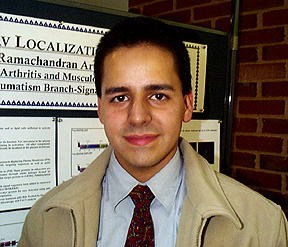 |
|
Jesus
Buonomo
|
Jesus
Buonomo, postbac, Arthritis and Rheumatism Branch, NIAMS:
Studies on Vav localization and function
Vav is a proto-oncogene that functions as a guanine nucleotide exchange factor for the Rho family of proteins and is believed to play an essential role in signal transduction of hematopoietic cells. The protein product of the Vav1 gene exhibits several structural motifs, including a conserved Dbl homology domain and an SH2 domain that interact with kinases, adaptor molecules, and negative regulators of signal transduction. Vav1 becomes associated with the plasma membrane of activated mast cells, in cholesterol-rich lipid rafts upon antigen cross-linking of the high-affinity receptor for Ige (FceRI).
Buonomo and his colleagues began their investigation by asking the question: "Is Vav1 localization to the plasma membrane and/or lipid rafts sufficient to activate function?" They looked for answers using co-localization studies with fluorescent or epitope-tagged constructs of Vav1. These constructs included sequences targeting Vav1 either to the plasma membrane (PM) or the lipid raft, as well as mutations in functional domains.
Preliminary results indicated that Vav1 localized to the PM as a micro-aggregate upon FceRI stimulation, but was not PM-associated in unstimulated cells. Further, they observed that FceRI and Vav1 co-localization was dependent on the SH2 domain of Vav1.
They also discovered
that Vav1 co-localized with LAT (linker of the activation of T cells), a protein
found in lipid rafts. The group now plans to study the effect of Vav1 localization
and function on signaling via the small GTPase Rac1 and c-jun NH2-terminal kinase
(JNK1). ![]()
| DIRECTORY ATTRACTS CRITICAL MASS TO MAKE A DAY OF IT | |
 |
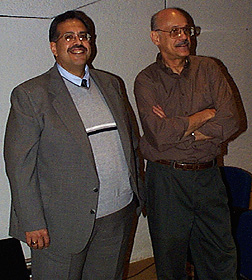 |
|
Mission
Accomplished (left
to right): Nancy
Vázquez-Maldonado, FDA; Carmen
Collazo-Custodio, NIAID; Carolina
Nadel, NCBI; and OIR Assistant Director Arlyn
García-Pérez, NHLBI , await the start of the day they
worked months to put together.
|
Juan
Rivera (left), NIAMS, delivered the keynote lecture at the NIH Hispanic
Scientists Day. Ray
Mejia, president of the NIH Hispanic Employee Organization, announced
two symposia on Health Disparities in Minority Populations September 15
and October 4.
|
|
The Hispanic Scientists Directory currently contains the names and biographical data of about 70 scientists at NIH and FDA—surely not the actual number of people of Hispanic origin that populate NIH and FDA labs, but a sufficient and growing number of self-subscribed individuals to build Hispanic Scientists Day at NIH. Whether this day will occur every year—and what forms recognition of the research of Hispanic scientists may take—is not certain, said Nancy Vázquez-Maldonado, a prime mover of both the directory and the day, but the professional and personal connections established through the directory are here to stay. The directory gives each person’s phone, fax, and e-mail; institute and lab; job title, degree, and degree-granting institution; dates of arrival and expected departure from NIH or FDA; research areas of interest; and country of origin. Most scientists now listed come from Puerto Rico and the countries of South America, with the remainder representing Mexico, Spain, Central America, Cuba, and the United States. The address is <ftp://helix.nih.gov/felcom/latino2.html>. Most scientists who have listed themselves in the directory, Vázquez-Maldonado said, credit it for having enabled them to connect with other Hispanic scientists—to collaborate or just to be able to speak Spanish. |
|